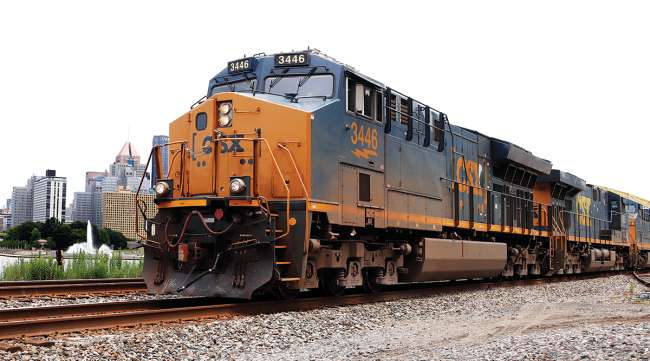Senior Reporter
CSX Reports Lower Q3 Net Income, Revenue

[Ensure you have all the info you need in these unprecedented times. Subscribe now.]
CSX Corp. reported a slip in third-quarter financial results due to the impact of the coronavirus pandemic on shipments.
Based in Jacksonville, Fla., the Class I freight railroad said net income fell 14% to $736 million, or 96 cents per share, compared with $856 million, or $1.08, in the same year-ago period.
Revenue dropped 11% to $2.64 billion compared with $2.97 billion last year.
The railroad’s operating ratio worsened slightly to 56.9 compared with 56.8 last year.
Operating ratio, or operating expenses as a percentage of revenue, is a key industry metric used to measure efficiency. The lower the ratio, the greater the company’s ability to generate profit.
The results beat Wall Street expectations. According to Zacks Consensus Estimate, analysts were expecting 93 cents per share. Company officials are optimistic that freight volume will pick up as economic activity improves.

Foote
“The last six months have truly been surreal. On last quarter’s call, we discussed the largest and most rapid sequential volume declines in CSX’s history. Now, just three months later, record sequential increases,” CEO James Foote said. “Think about that: Volume declines and increases twice as steep as the largest wins we experienced in the great recession in a span of just a few months.”
The railroad ended the quarter with 9.4% fewer employees than at this time in 2019, shedding 2,018 positions for a headcount of 19,313.
CSX is one of several Class I railroads that has moved to become more efficient by using precision scheduled railroading. PSR involves moving freight with fewer railcars and locomotives using a more simplified, direct line of transport across the network.
The company said the combination of fewer employees and reduced crew starts saved $71 million.
The glut of diesel, caused by the deep drop in demand for petroleum products during the coronavirus, led to a 36% drop in fuel costs and a savings of $104 million.
“Partially offsetting the ongoing revenue headwinds, overall expense was down 11% on a 3% decline in volume. Walking down the expense line items, labor and fringe was 10% lower, reflecting significant efficiency improvements and lower volume-related costs,” Chief Financial Officer Kevin Boone said.
Revenue from all sectors for which the railroad carries freight declined:
- Automotive — 7% to $102 million in 2020 from $110 million in 2019.
- Metals and Equipment — 11% to $58 million from $65 million.
- Agriculture and food products — 3% to $115 million from $119 million.
- Chemicals — 1% to $165 million from $166 million.
- Forest products — 8% to $67 million from $73 million.
- Minerals — 4% to $86 million from $90 million.
- Fertilizer shipments — 5% to $57 million from $60 million.
As the economy shows signs of recovery, company officials are optimistic the numbers will improve in the fourth quarter.
“We were encouraged by the speed at which volumes recovered from the trough, particularly the strength in the intermodal market. Fourth-quarter volumes to date are up year-over-year and we all hope for continued positive economic momentum,” Foote said.
Want more news? Listen to today's daily briefing:
Subscribe: Apple Podcasts | Spotify | Amazon Alexa | Google Assistant | More




